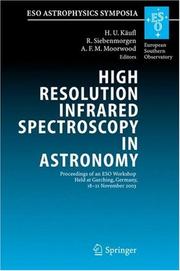| Listing 1 - 2 of 2 |
Sort by
|

ISBN: 3540252568 9786611390068 1281390062 354031606X Year: 2005 Publisher: Berlin, Heidelberg : Springer Berlin Heidelberg : Imprint: Springer,
Abstract | Keywords | Export | Availability | Bookmark
 Loading...
Loading...Choose an application
- Reference Manager
- EndNote
- RefWorks (Direct export to RefWorks)
Two specialized new instruments for ESO's VLT, VISIR and CRIRES, spawned the idea for this workshop. CRIRES is a dedicated very high resolution infrared spectrograph; VISIR features a high resolution spectroscopic mode. Together, the instruments combine the sensitivity of an 8m-telescope with the now well-established reliability of VLT-facility instruments. High resolution here means that lines in cool stellar atmospheres and HII-regions can be resolved. The astrophysical topics discussed in this rather specialized workshop range from the inner solar system to active galactic nuclei. There are many possibilities for new discoveries with these instruments, but the unique capability, which becomes available through high-resolution infrared spectroscopy, is the observation of molecular rotational-vibrational transitions in many astrophysical environments. Particularly interesting and surprising in this context, many papers on modeling and laboratory spectroscopy at the workshop appear to indicate that astronomical observations are lagging a bit behind in this field. The papers are an interesting mix of reports from existing high resolution facilities, reports on modeling efforts of synthetic spectra and reports on laboratory spectra. In this sense, a fruitful exchange between molecular physics and astronomy was again accomplished and is documented in this volume.
Infrared astronomy --- Infrared spectroscopy --- Astronomical spectroscopy --- Spectroscopie infrarouge --- Spectroscopie astronomique --- Congresses. --- Congrès --- Astrophysics --- Astronomy - General --- Astronomy & Astrophysics --- Physical Sciences & Mathematics --- Congrès --- EPUB-LIV-FT SPRINGER-B --- Physics. --- Astronomy. --- Astrophysics. --- Cosmology. --- Astronomy, Astrophysics and Cosmology. --- Astronomical physics --- Astronomy --- Cosmic physics --- Physics
Book

ISBN: 2759824829 Year: 2021 Publisher: Les Ulis : EDP Sciences,
Abstract | Keywords | Export | Availability | Bookmark
 Loading...
Loading...Choose an application
- Reference Manager
- EndNote
- RefWorks (Direct export to RefWorks)
Driven by ground-based, airborne, and IRAS observations, the PAH hypothesis was first formulated in the mid-eighties : the widespreas emission features in the 3-13 µm range are due to UV-pumped, IR fluorescence by large Polycyclic Aromatic Hydrocarbon molecules. These molecules are a ubiquitous component of the insterstellar medium both in local galaxies as well as out to redshifts of ~3 and probably beyond, play an important role in its physical and chemical characteristics, and form a key link between small hydrocarbon species and large carbonaceous grains. This book gathers contributions that reflect the evolution of the field over the last 25 years, taking advantage of IR space missions - ISO, Spitzer and AKARI - and of dedicated experimental and quantum-chemical studies. We have now reached a stage where we can develop these mid-infrared features as diagnostic tools to study star formation processes, protoplanetary disks as well as galaxy assemblage in the early Universe. The current Herschel/Planck area opens the possibility to better characterize the mid-IR carriers through their contribution to the far-IR and mm emissions. Still, much effort is required before we will fully understand the formation and nature of interstellar PAHs and their role in the Universe. Physical chemists can play an important role in driving this field. This book aims at discussing the state-of-the-art of the PAH hypothesis and to chart the future in this interdisciplinary field. It highlights the various aspects of interstellar PAHs: - Rich IR spectra of interstellar PAHs - PAHs and star formation in the near and far Universe - The lifecycle of PAHs in space - PAHs in regions of planet formation - PAHs and carbonaceous grains & Solar system materials.
| Listing 1 - 2 of 2 |
Sort by
|

 Search
Search Feedback
Feedback About UniCat
About UniCat  Help
Help News
News